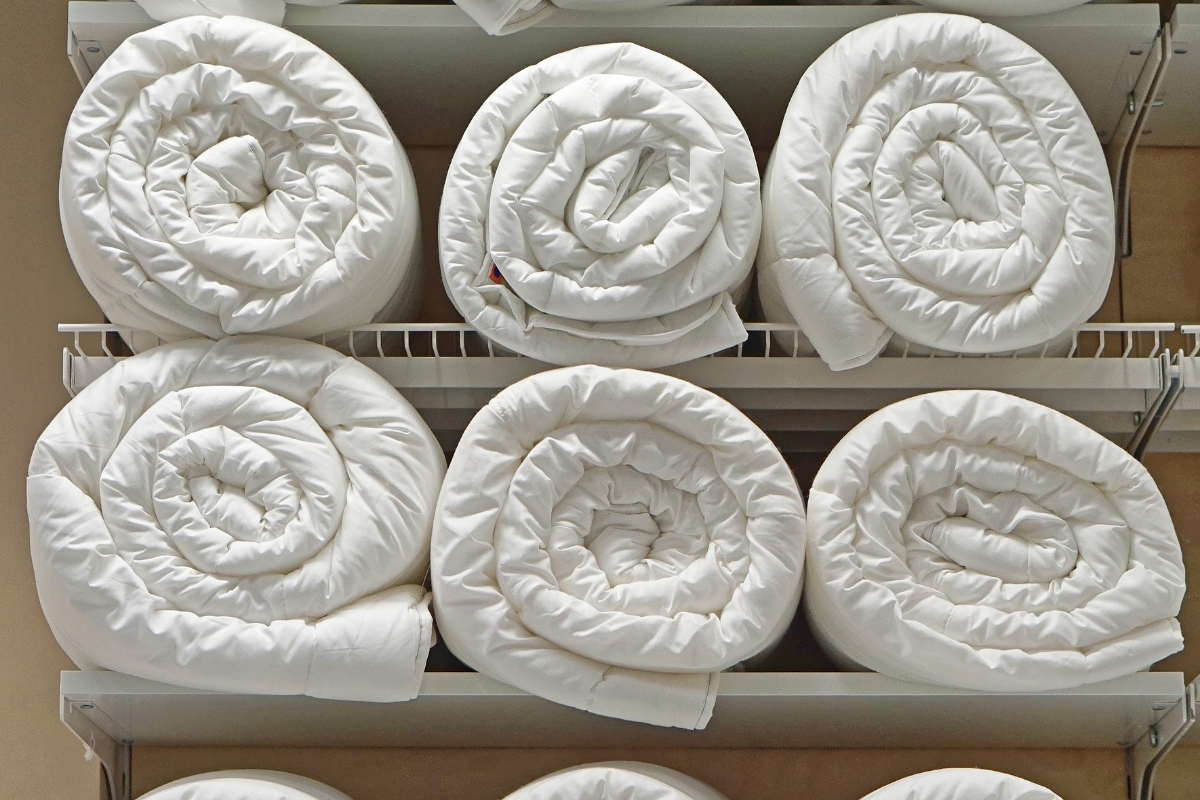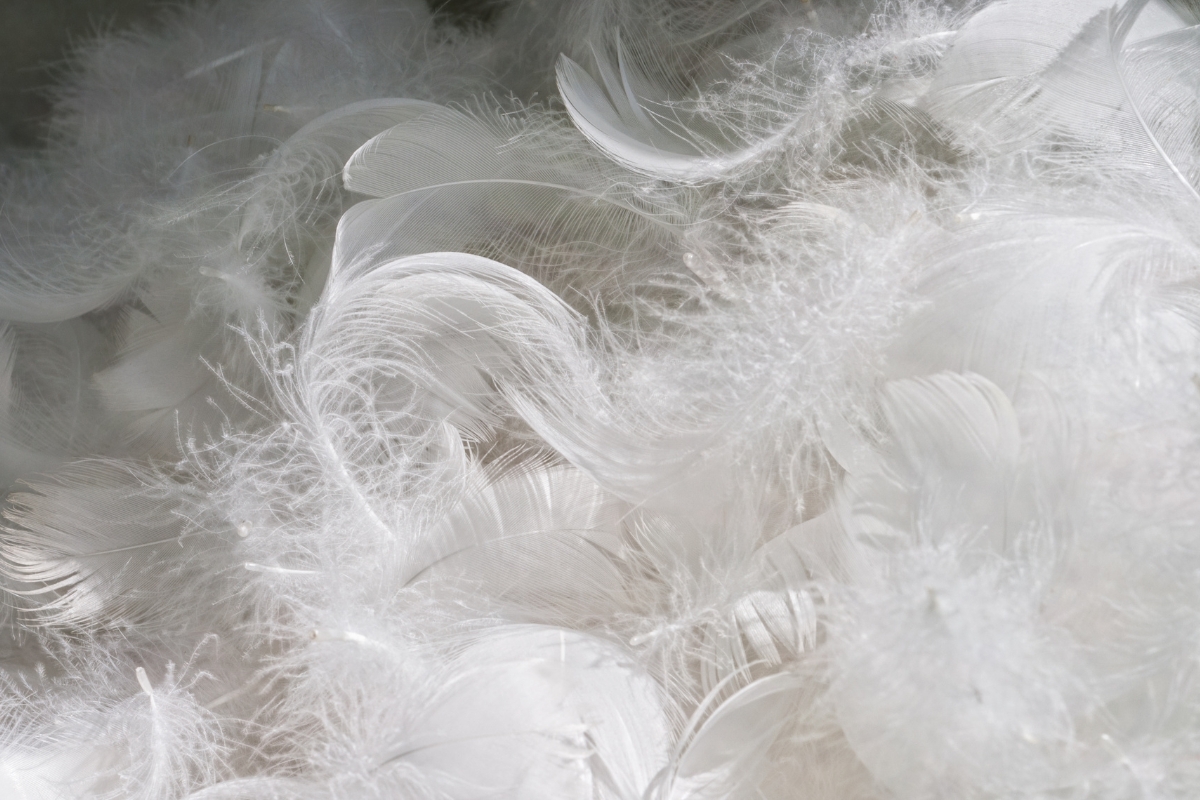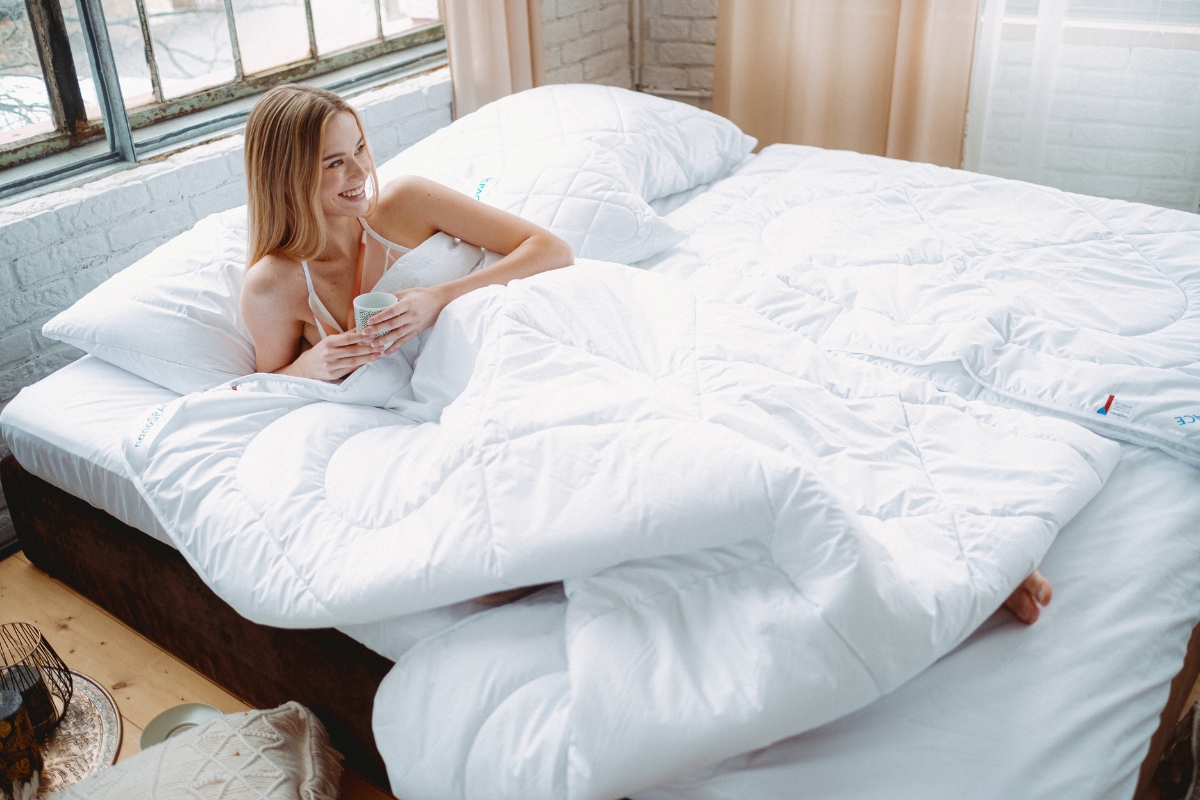Does your duvet or blanket need washing? If your duvet fits into the washing machine, washing duvets isn't complicated. Just follow basic instructions. Let's see how to wash hollow fiber duvets, nanofiber duvets for allergy sufferers, and feather duvets.

How to Properly Care for Duvets and Blankets
You should regularly air out duvets and blankets, especially if your place is dusty and you don't use allergy-proof bed linen, which prevents dust and dust mite accumulation on the duvet. You should occasionally wipe it with a damp cloth or vacuum it to remove dust. Duvets also deserve washing once a year.
Duvets with nanofiber membranes can go longer without washing as they prevent the accumulation of bacteria, viruses, dust, and mites in the filling. However, they don't prevent sweating, so even an allergy duvet should be washed occasionally.

How to Wash Feather Duvets
Feather duvets should be washed at least once a year. If you suffer from dust mite allergies, you probably have an anti-mite cover on your duvet, so you don't need to wash it as often because mites and their allergens won't get into it. However, if you've recently been ill or sweat more, you should wash your duvet more often or at least air it out once every 2-3 months.
Can Feather Duvets Be Washed at Home?
Only some can, so always check the label on your duvet. If there's a symbol indicating that the duvet can be washed in a washing machine, make sure you have a machine big enough for it. However, if you have a winter or thermo duvet, you'll probably still need to have it cleaned at the dry cleaner's.
What to Do Before Washing Duvets
Ensure that the washing machine is clean, or clean it before washing with eco-friendly cleaning tablets. Check the label on the duvet to see if it's washable and look at the maximum washing temperature. Do not add any other laundry to the washing machine.

Washing Feather Duvets Step by Step
- Before washing feather duvets, make sure the washing machine is large enough to accommodate them.
- Inspect the feather duvets and remove any stains or spots before placing them in the washing machine.
- Use a gentle detergent specifically designed for feather duvets. Avoid using fabric softeners and conditioners, which could damage the feathers.
- Set the washing machine to a delicate cycle and choose a temperature no higher than 40 degrees Celsius. Higher temperatures could damage the feathers.
- After washing, allow the duvet to dry thoroughly to prevent mold growth.
How to Dry Duvets?
Properly drying feather duvets is as important as washing:
-
Air drying: It is recommended to air dry feather duvets, preferably outdoors. Hang it on a clothesline or drying rack and let it hang freely.
-
Remember to fluff it: Before hanging, give the duvet a good shake to evenly distribute the feathers inside.
-
Additional drying in the dryer: If necessary, you can put the feather duvet in the dryer on a low temperature. You can add tennis balls or special balls to the drum to evenly distribute the feathers inside the duvet during drying.
How to Wash Hollow Fiber Duvets
Hollow fiber is currently the most popular filling for duvets because they are easier to maintain and you can choose duvets with different levels of warmth. They are often advertised as suitable for allergy sufferers, but be careful. Hollow fiber duvets are certainly more suitable for feather allergy sufferers, but they won't help people with dust mite allergies. Dust mites actually like hollow fiber even more than feathers because they have more space to hide. If you have an allergy sufferer at home, always opt for duvets for allergy sufferers with a nanofiber membrane that mites cannot penetrate. But now let's look at how to wash hollow fiber duvets.
How to Wash Hollow Fiber Duvets
When washing duvets and pillows made from hollow fiber, there's no need to use any special laundry detergents. You can safely opt for a standard laundry detergent suitable for white laundry, readily available on the market. Another option is to use a liquid detergent designed for white laundry from various brands. We recommend eco-friendly and skin-friendly laundry detergents, but the choice is yours.
If you decide to dry the duvets in an automatic dryer, avoid using fabric softener. Fabric softener can cause fiber release, which could clog the dryer filters.
What Temperature to Wash Hollow Fiber Duvets?
To maintain the quality and longevity of hollow fiber duvets and pillows, it's important to follow the correct temperature regime when washing. It's usually recommended to wash them at temperatures between 40 and 60 degrees Celsius. You can find precise information about the suitable temperature for specific products on their label. Remember that higher temperatures can damage the hollow fiber. If the hollow fiber is damaged, it may not insulate as well, and the duvets may become "flat."
What Size Washing Machine Do I Need for Washing Hollow Fiber Duvets?
Before you start washing, make sure your washing machine meets the necessary parameters for washing hollow fiber duvets. It's important to consider the capacity of the washing machine and whether it can handle the volume and weight of these products. If your duvets and pillows belong to the category of standard sizes (for example, 140x200 cm), a washing machine with a capacity of 6 kg should be sufficient for washing them. However, if you have duvets or pillows with a larger volume, such as for a French bed, you'll likely need to use a dry cleaner.
How Often Should I Wash Hollow Fiber Duvets?
Wash duvets 1-2 times a year and regularly air them out. Washing more frequently can quickly deteriorate the duvet.
How to Properly Dry Hollow Fiber Duvets?
For longer life, it's preferable to let the duvet air dry, ideally in fresh air. However, this is not suitable for pollen allergy sufferers during pollen season. If you have a dryer, you can use it, but you need to set it to lower temperatures. Just like when washing duvets, you can add a tennis ball or other special drying ball or egg to the drum to evenly distribute the hollow fiber in the duvet.
How to Wash Duvets with Nanofiber Membrane for Allergies?
If you own a duvet with a nanofiber membrane, you have a huge advantage in maintenance. These special duvets prevent dust mites, bacteria, dust, and viruses from penetrating. As a result, less frequent maintenance is required, and it's recommended to vacuum or wipe the duvet with a cloth every 3-6 months. Only wash the duvet if it's soiled or sweaty.
#produkty#https://www.nanospace.store/anti-dust-mite-bedding/
How to Wash nanoSPACE Allergy Bedding
For washing these duvets, it is advisable to use laundry gel or powder without chlorine and phosphorus to avoid damaging the nanofiber membrane. Ideally, use ecological and gentle laundry products suitable for allergy sufferers.

To What Temperature to Wash nanoSPACE Duvets
To preserve the quality and lifespan of nanofiber bedding, it is recommended to wash them at a maximum temperature of 40°C. Remember, higher temperatures may damage the nanofiber membrane and hollow fiber filling. Damaged hollow fibers may not insulate as well, and damaged nanofiber membranes may compromise mite protection. Therefore, use lower wash temperatures to ensure longer lifespan and effectiveness.
How Big of a Washing Machine Do I Need for Washing nanoSPACE Bedding?
In nanoSPACE, we offer various sizes and types of bedding. A standard year-round bedding for a single bed fits in a washing machine with a capacity of over 6 kg. However, you may encounter problems with winter and thermal bedding. Similarly, a double bed bedding may not fit into the washing machine and it may be more suitable to take it to the dry cleaner.
How Often to Wash nanoSPACE Bedding with Nanofiber Membrane?
Air and dust the bedding regularly to remove dust and dirt that the nanofiber membrane does not allow into the filling. You can also use a vacuum cleaner for this purpose. It is sufficient to wash the bedding once a year, depending mainly on whether it is visually soiled or sweaty.

How to Properly Dry nanoSPACE Bedding?
Avoid drying the bedding in a dryer to prevent damage to the nanofiber membrane, and let the bedding dry on a rack, ideally in fresh air. However, this is not suitable for pollen allergy during pollen season.
How to Care for Bedding Made of Other Materials?
There are also many other types of bedding that require specific care, always check the label! For example, woolen bedding and pillows require special care, and when washing, it is advisable to use lanolin, which maintains the properties of woolen material. If you are unsure, always consult the manufacturer before washing.
FAQ – Most Common Questions and Answers
How often do I need to wash bedding with a nanofiber membrane?
Bedding with a nanofiber membrane is recommended to be washed once to twice a year.
What laundry detergents are suitable for washing bedding with a nanofiber membrane?
Use laundry detergents without chlorine and phosphorus.
Can I dry bedding with a nanofiber membrane in a dryer?
It is not recommended to dry bedding with a nanofiber membrane in a dryer, not even on a low temperature. It is best to let it dry freely in the air.
How often should I ventilate bedding with a nanofiber membrane?
1x every 2-3 months
How often should I wash feather bedding?
Feather bedding should be washed at least once a year. In case of allergies, illnesses, or increased soiling, it is advisable to wash them more frequently.
Can feather bedding be washed at home?
Yes, it is possible to wash feather bedding at home if you have a washing machine with sufficient capacity. However, bulkier duvets will need to be taken to the dry cleaner.
How should I prepare feather bedding before washing?
Wash feather bedding separately from other laundry and make sure the washing machine is clean. You can use a special washing machine cleaner to remove odors and dirt.
What laundry detergent should I use for washing duvets?
Choose a gentle laundry detergent specifically designed for feather bedding. Avoid fabric softeners and conditioners that could damage the feathers.
How should feather bedding be properly dried?
Dry them either on a rack or at low temperatures in the dryer.
How often should I wash hollow fiber bedding?
It is recommended to wash hollow fiber bedding at least once a year.
Can hollow fiber bedding be washed at home?
Yes, you can wash them in the washing machine if they fit.
How should I prepare hollow fiber bedding before washing?
There is no need to prepare them in any way, just if they have dried stains, it is recommended to use a stain remover before washing.
What laundry detergent should I use for washing hollow fiber bedding?
For washing hollow fiber bedding, it is advisable to choose a gentle laundry detergent specifically designed for these materials. Avoid fabric softeners and conditioners that could damage the fibers.
How should hollow fiber bedding be properly dried?
Dry them in fresh air on a rack or in the dryer at low temperatures.

